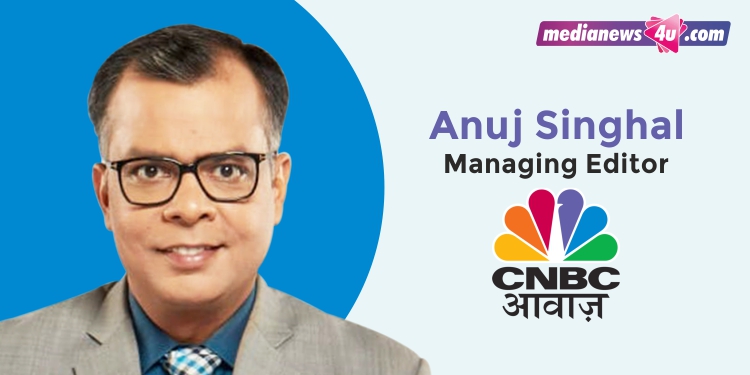Anuj Singhal, the Managing Editor of CNBC-Awaaz, is among India’s most seasoned and popular stock market anchors. He has been with Network 18 since he joined CNBC-TV18 as a Research Analyst straight out of college in 2003.
Singhal has tracked the Indian financial markets for the last two decades and between 2013-2022, he was the lead anchor for both the market flagship shows of CNBC-TV18 – Bazaar and Closing Bell. He was elevated to the post of Managing Editor of CNBC-Awaaz in September 2022. Since then, he has been instrumental in shaping the leadership position of the channel, both on TV and digital.
In an exclusive interaction with MediaNews4u.com, Singhal speaks about the uniqueness of a stock market anchor, relevance of Hindi business news in the age of finfluencers and offers advice on how one can build a corpus in the long run by investing smartly. Edited Excerpts:
In the age of online trading platforms, finfluencers and self-styled analysts, how does CNBC-Awaaz manage to stay relevant to the audience?
It comes down to the trust that people have in a brand like CNBC-Awaaz, and people like me and some of my colleagues like Verendra, Ashish, Neeraj, Harsha, Manisha and Dipali, along with our reporters. As a team, we have created a strong brand.
CNBC-Awaaz has been very strong for nearly 20 years. While we have lots of finfluencers and analysts, the track record comes in handy. They might have had a great start but many struggle to maintain their credibility in the long run.
While CNBC-Awaaz is a traditional media, we have made huge strides in digital media ourselves. Lot of us have a large social media following and many of our videos go viral on social media platforms like Twitter (X) and Insta. So, it is not that we have let the individuals and finfluencers to come and overtake us.
We have also created an exponential track record. As a medium, we have a great responsibility towards the investors and trading community, hence we ensure that we will not cross the line drawn by the market regulator (SEBI). All participants on CNBC-Awaaz are SEBI-registered and we never engage even a single analyst who is not registered with SEBI. This uniqueness helps us command great credibility in front of individuals, because when it involves someone registered with SEBI, there is always a mechanism for grievance redressal. Through these factors, we not only stay relevant, in fact we are increasing our relevance day by day.
How does the role of a stock market anchor differ from a traditional news anchor?
First of all, we don’t have a script, because the stock markets are always live. Barring headlines everything is impromptu. We are not just an anchor who is reading news, we either report on the stock market or interact with our guests about the market or about their company. In that sense, we cannot come with any prepared questionnaire because the interaction involves cross questions based on the answer from the guests. For example, if the CEO of a company gives us a breaking news story, then regardless of what you are interviewing him about, the focus of the questioning will be shifted towards the elements surrounding the breaking news.
One important aspect that differentiates a stock market anchor from news anchor is, whatever he says will directly impact the lives of the people in terms of their money. We need to disseminate live inputs to our audience quickly while ensuring that it is accurate. This combined demand makes the life of a business news anchor more stressful than the regular news anchor.
We always face the dilemma of whether we need to be first or we need to be accurate. But in reality, we have to be first as well as accurate.
What is the audience profile of CNBC-Awaaz. Can you take us through the viewership engagement metrics of your TV and digital platforms?
The audience profile of CNBC-Awaaz is very diversified. A lot of our viewers are first time investors who just walked out of college or someone who got his first job and is planning to invest some money into personal finance, real estate, commodities etc.
CNBC-Awaaz not only caters to the stock market, it covers the whole spectrum of financial advice that includes gold, silver, real estate. During the trading hours, 90 pc of our focus will be towards the stock market. Once the stock market closes, we shift our focus entirely towards commodities and in the evening we move completely towards personal finance. Hence, anyone who wants information on finance is our viewer.
A lot of retired people investing their money in stocks watch us, corporates follow us closely, people in the dealing rooms of the stock market track us during the trading hours. Data revealed that students watch us to invest their pocket money in shares. The traders are our major audience, the big trading markets of Gujarat like Ahmedabad, Surat and Mumbai (Ghatkopar) follow us across the day.
On digital we get people of diversified profiles follow us on Facebook, Instagram and Twitter (X) and we command chart-topping views.
Recently we observed a shift in trends. When we started, our audience profile was largely Male 40-plus, but recently we could see a lot of younger audience like college students started watching us for their investment decisions.
Any data points on male vs female ratio on viewership?
The ratio right now is 80 percent men and 20 percent women. Earlier it was even more skewed towards male and in recent times the share of females has increased to 15 percent. We aim to make it 50:50. As part of our efforts in this direction, CNBC-Awaaz is trying to rope in more female analysts in our airtime. We try to identify the successful women traders and try to feature them on our channel. We would be happy to see the ratio improving to 60 percent men and 40 percent women in the near future.
Which are the reach markets for CNBC-AWAAZ and is there a significant shift happening towards Hindi business news?
CNBC-Awaaz and many other Hindi business news channels largely focus on retail viewers. I think we understood this game fairly earlier as the real viewership comes from the masses hence the focus was on retail. This approach helped the Hindi business news genre to grow significantly. Even in markets like down South and East India where English is expected to do far better, CNBC-Awaaz is commanding significant viewership. In cities like Bengaluru and Chennai, CNBC-Awaaz and Hindi is having a huge influence.
Today Hindi business news is bigger than English business news with Hindi controlling 75 pc of the overall business channel market. Presently CNBC-Awaaz is the leader as per BARC data while Zee Business has just started subscribing to BARC.
What is the impact of CNBC-Awaaz on investors, businesses and policy decisions?
CNBC-Awaaz is playing a pivotal role in influencing many state and central government decisions as they follow us regularly to understand consumer behaviour and mindset. Recently when I met the Finance Minister of Gujarat, he said that they follow CNBC-Awaaz on a day-to-day basis and how it was useful in their decision making. Similar sentiment was reflected by the Union Ministers Nirmala Sitharaman and Piyush Goyal when I met them recently.
On the business side, small investors who don’t have the access to data and inputs that are available for institutional investors, rely on us studiously for crucial market updates. Large corporates reach us for major announcements like IPO and related communications which they want to covey to the market. Similarly, they also talk to us after every quarterly result to retain the investors’ confidence positively.
Do you see a scope for the AI news anchor on CNBC-Awaaz?
I would hope not. Today the news anchoring is all about creating a face and reading the news. But AI is everywhere. However, an AI anchor entering the stock market will take some time. In general, news anchoring is all about creating a face and reading news. In stock market there is an emotion involved.
When the market falls your energy level changes and when it rises your energy level gets pumped up. People connect with that emotion which AI would still not be able to express. An AI might read news, stock prices and every other information but it won’t be able to connect with the greed and fear which drives the stock market.
So, right now I don’t see an AI anchor doing that, but 10 years later who knows it might happen.
How are brands responding towards the platform? Which are the top categories?
Lot of our advertisers come from real estate and related space and financial market platforms. Business news genre is preferred by real estate-oriented categories such as wires and cables, tiles and ceramics. Even today, home is seen as the biggest investment. So whatever the money that investors earn from the stock market is getting invested in real estate. In the financial services category, a lot of fintech platforms depend on us. Government ads are another major advertising revenue option for this genre.
As a person who has been tracking markets ever since walking out of the college, which according to you is the best performing stock till date and what is your tips to the Indian investors for next 12 months?
There have been so many stock in the Indian market that multiplied hugely since I entered the market. HDFC Bank, Infosys, TCS, Lupin, Pidilite, Asian Paints, Kotak and I can quote so many such stocks. But Infosys and HDFC Bank are the stocks which did extremely well in terms of creating pure wealth to the investors. They are the large stocks which represent India.
My advice to people is, invest in India. Even if someone is poor in stock selection, be disciplined and keep investing in Nifty via ATF or Nifty fund, keep doing systematic investments plans (SIP) in index you will be able to build a lot of corpus. For example, if you invest in Nifty right now, not even stocks, in 20 years you will be able to make twenty times from current levels.
Believe in the India story and keep investing in India.
Feedback: [email protected]

















